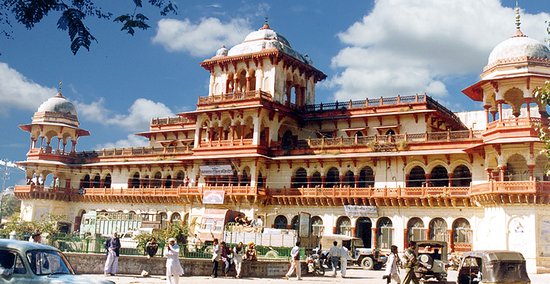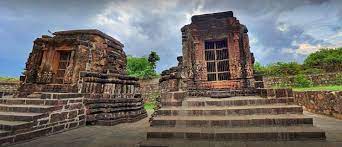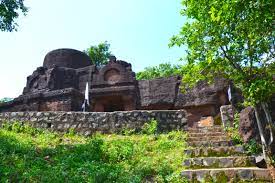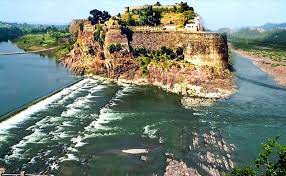- Private car and driver in Delhi / India
- +91-8447445445
- info@discoverindiabycar.com sugar.ankit@yahoo.com
 +91-9818434712
+91-9818434712
Jhalawpur
Jhalawar, a 19th-century kingdom south of Kota. Is situated in one of Rajasthan’s most picturesque and unexplored regions. The British dismembered the state of Kota in 1838 to create the new principality of Jhalawar for the descendants of the famous Zalim Singh. Madan Singh, who acknowledged British supremacy, became the first ruler of this new principality and was given the title of Maharaj Rana under a treaty signed the same year. Jhalawar, or “land of the jhalas” – a brave Chauhan Rajput warrior clan – has a valiant past, and the unexplored treasures of history in this region are a great draw for the adventurer and historian.Because of the jhalarpatan units’ suburbs, it is better known as a temple town. Many of these temples are several centuries old.
Climate
The average summertime temperature is around 40 °C (104 °F), although it can get as high as 45 °C (113 °F) at its highest. Wintertime lows can drop as low as 1 °C (34 °F). The district of Jhalawar receives the most rain in the state of Rajasthan. It receives an average of 37 inches (940 mm) of rain annually, and light breezes keep the oppressive humidity at bay.
Location
In the Jhalawar district of the Indian state of Rajasthan, there is a city, a municipal council, and the district headquarters. It is located in the state’s southeast corner. It serves as the administrative centre for the Jhalawar district and served as the erstwhile princely state of Jhalawar’s capital. Jhalawar serves as its district capital.
History of Jhalawpur
A Rajput named Jhala Zalim Singh, who was the Dewan of Kota State at the time, created the city of Jhalawar (1791 A.D.). He created a cantonment in this township, which was formerly called as Chaoni Umedpura. At the time, there were extensive forests and animals all around the township. Jhala Zalim Singh frequented this location for hunting, and he loved it so much that he intended to turn it into a community. Because Maratha invaders used this strategic location as a crossing point on their way from Malwa to Kota in order to seize Hadoti territories, it was decided to build this area as a military cantonment. In order to use this location to battle and repel Maratha invaders before they reached Kota state, Jhala Zalim Singh began to construct it as a military cantonment and township. He did this because he understood the significance of the location. Around 1803–1804 AD, the cantonment and township of Chaoni Umedpura were built. When Colonel Todd visited the area in December 1821, he characterised it as the cantonment that Jhala Zalim Singh had built in addition to a well-established township with sizable homes, havelis, and boundary walls.
How to Travel Jhalawpur?
You can travel Jhalawpur by private car and driver from Delhi. Discover India By car provide best tour packages for Jhalawpur. One the the best tour package for Jhalawpur by private car and driver is Royal Rajasthan Package by discover India by car.
Jhalawar's Major Tourist Attractions
Palace at Jhalawar Fort
This beautiful monument, located in the town centre, now houses the Collectorate and other offices. It was built by Maharaja Madan, and there are paintings inside the rooms that can be viewed with the permission of the offices located here or the tourist office in charge. The exquisite paintings and mirrors on the walls of ‘ZananKhana’ are especially noteworthy.


Natya Shala Bhawani
In 1921, Maharaja Bhawani Singh built an interesting building on the grounds of the fort. This one-of-a-kind theatre was built to host plays and other cultural events. It was a popular Parsi theatre in the former state. It was recently revived and provides an excellent insight into the period’s theatrical art.
Temple of Chandrabhaga
This complex, located on the banks of the Chandrabhaga River, contains many beautiful temples, some of which date back to the 7th century. The temple architecture of the Chandramaulishwarmahadeo temple is excellent. The carved pillars, arched gateways, and exquisite craftsmanship distinguish these temples.


Jhalarpatan
Jhalarpatan, or Bella’s City, is an ancient walled city. JhalaZalim Singh founded it in 1796. It is located in the same location as the ancient town of Chandrawati, which was founded by the parmar raja Chandrasen and later destroyed by invaders. The entire township is surrounded by a wall. It is thought to have been built to protect trade caravans from the depredation of the pindaris, as patan happened to be one of the caravan route’s junctions.The 9th century surya temple (Padam Nath Temple) is Jhalapatan’s pride and joy. Surya’s idol and the beautiful sculptures on this massive temple are impressive. It is considered to be one of the best examples of temple architecture in North India.
Buddhist stupas and caves
Jhalawar district is home to Rajasthan’s only rock-cut cavers. The ancient Buddhist caves in village Kolvi are significant both archaeologically and historically. Some of the caves’ highlights include a colossal Buddha figure and carved stupas. Similar caves have been discovered in Vinaika, Hathiagor, and Gunai, demonstrating that a thriving civilization existed here several centuries ago, and the Buddhist influence in the region is clearly visible.


Fort Gagron
The foundation of this magnificent, impregnable renowned fort was laid in the seventh century, and the fort was completed in the fourteenth century. Out of the nine durgs or forts mentioned in the Shastras, it is an example of a ‘jaldurg.’It is surrounded on three sides by water from the Ahu and Kali Sidh rivers, and its ramparts provide a breathtaking view.The Dargah of Sufi saint Mitheshah, located outside the fort, hosts an annual fair during the month of Moharram. A monastery dedicated to Saint Pipa, a contemporary of Saint Kabir, is nearby.








